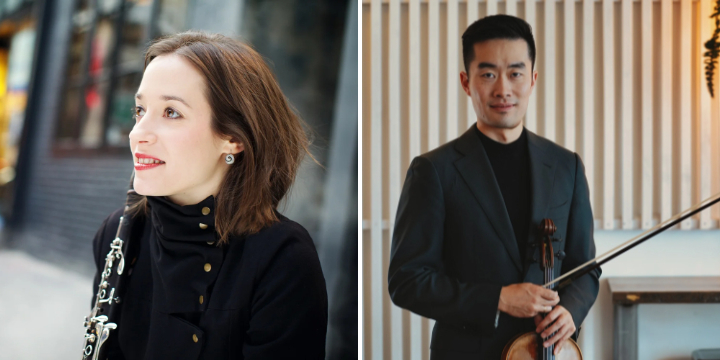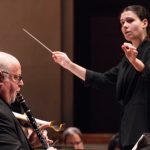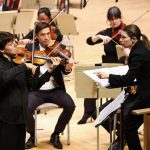October 7, 2025
Stude Concert Hall, The Shepherd School of Music
Houston, Texas – USA
Dover Quartet (Joel Link and Bryan Lee, violins; Hezekiah Leung, viola (guest); Camden Shaw, cello); Romie de Guise-Langlois, clarinet.
Joseph HAYDN: Quartet in D major, Op.20 No. 4 (1772)
Pierre JALBERT: Equilibrium (2024) for B-flat Clarinet and String Quartet (Texas Premiere)
Wolfgang Amadeus MOZART: Quintet in A major, K. 581 (1789)
Lawrence Wheeler | 10 OCT 2025
Tuesday evening, Chamber Music Houston presented the second concert of its 66th season at Stude Concert Hall, featuring the Dover Quartet and clarinetist Romie de Guise-Langlois. As with the Balourdet Quartet last month, performing at the Shepherd School is a homecoming of sorts, since the quartet trained there 14 years ago. Ms. de Guise-Langlois last appeared on the Stude Concert Hall stage 16 years ago as the winner of the 2009 Houston Symphony Ima Hogg Young Artist Competition—back when it was a major competition with international applicants and before it was ceded to the Texas Music Festival in name only.
Although the first string quartets were written some 60 years earlier, Haydn’s six Op. 20 string quartets were the first great works in this genre. Their historical importance cannot be underestimated. Called “the father of the string quartet,” Haydn established the form, setting the model for the next 250 years—four movements, each with a different form, tempo, and meter, enabling infinite variety.
Violist Hezekiah Leung was a last-minute substitute for Julianne Lee. Having played with the quartet for a year, two years ago, he fit hand in glove, contributing to the group’s impeccable balance and intonation. The first movement, “Allegro di molto,” features piano portato quarter-notes played in unison. These floated off the Stude Hall stage with an arresting tone, setting the stage for a most enjoyable performance. Brilliant forte triplets alternated with the softer first motive. Initially traded between first violin and cello, the inner voices soon joined them. Exchanges were seamless, and forte unisons were flawless.

L: Romie de Guise-Langlois (credit: Claire McAdams)
R: Hezekiah Leung (canadianchamberorchestra.ca)
The second movement, “Un poco adagio e affetuoso,” is a theme and four variations. Passed from first to second violin, then cello, and back to the first violin, it was expressively played with gorgeous sound and varied colors.
In place of a Minuet, the third movement, “Allegretto alla zingarese” (“in the Gypsy style”), features displaced beats, feeling more in two than three. While not called a Scherzo, the tempo and character point to the Scherzos in Haydn’s Op. 33 string quartets. The Dovers played this with energetic abandon. Camden Shaw eloquently played a decidedly more polite cello solo in the Trio section. Marked “Presto scherzando,” the frolicsome Finale was a virtuoso vehicle for Joel Link. Played across a wide range of dynamics with technical sophistication that belied its difficulties, nothing was missing with this Link. I found myself smiling the whole time.
Pierre Jalbert is a highly productive and successful composer, with a catalogue of more than 70 works—half of them chamber music—that have been performed by leading musicians and ensembles. He is a formalist composer who focuses more on structure and technical construction, expressing an idea as opposed to a program. Tonight marked the third performance and the Texas premiere of Equilibrium, a co-commission by CMH and other organizations. Jalbert stated that music reflects the time in which it was created, observing that the world is currently very unbalanced. Written in three movements, the theme of Equilibrium is balance. The music conveys a state of mind rather than being overtly emotional. As with several of his other works, Jalbert explores opposing realms—the visceral and the spiritual, or lyrical and rhythmic. This formal concept also reflects the Baroque duality of sacred and profane, or expressive and strict.
The first movement, titled “Still/Animate,” is self-explanatory. In three parts (ABA), it begins with the strings playing fifths non-vibrato, creating a placid effect. The clarinet joins in with lyrical and lightly syncopated lines that sound Copland-esque. The strings then initiate quick figures that make the music rhythmically animated, prominently featuring the clarinet. The music has multiple layers, similar to Leoš Janáček’s string quartets. Returning to the first part, the movement ends quietly.
The second movement, “Chant,” again begins with open fifths in the strings. Leaping a dozen centuries, it makes reference to a Gregorian chant from the medieval period, or the Middle Ages. While a chant is monophonic (a single unaccompanied voice), Jalbert gives it a contemporary texture. Serene and luminous, it is notable for three alternating instruments playing in unison, with a glowing effect. The movement ends with open fifths.
The third movement, “Tipping Point,” is propelled by a fast ostinato in the strings that is animated, syncopated, and always on the brink. The clarinet interjects before beginning a series of fast-moving virtuosic leaps, concerto-style. The music becomes frantic, with echoes of bebop—at times sounding like a swirling top ready to tumble. Spent, the music ends quietly, returning to the very beginning with its open fifths. With the fifths coming full circle, it is open to interpretation whether we have fallen over the precipice or saved ourselves in time.
The performance was splendid. De Guise-Langlois played with character and animated eye movements, keeping in constant contact with the other musicians. Using a fluid and varied tone, she played with a discreet amount of volume and freedom. The quartet musicians gave a committed performance.
Mozart’s Clarinet Quintet was originally written in 1879 for basset clarinet and its co-inventor, Anton Stadler. Mozart wrote two other pieces for Stadler—the “Kegelstatt” Trio for viola, clarinet, and piano (1786), and the Clarinet Concerto in A Major (1791). The Quintet is one of the great chamber music works, and this evening’s performance gave it full justice. Using a customary “A” clarinet, de Guise-Langlois produced a beautifully vocal tone (without vibrato, of course) accompanied by a facile technique. Ensemble with the quartet was tight but not rigid. Subtle tempo changes highlighted the work’s different characters and emotions.
The first movement is fairly equally written for all five instruments. Beautiful melodic lines and virtuoso runs were passed off with panache. The “Larghetto” is like a concerto movement for clarinet, accompanied by muted strings. At the beginning, there was a slight bobble in the clarinet that was atmospheric rather than technical. The music proceeded unabated, with de Guise-Langlois maintaining long lines by means of circular breathing. Her concept of the movement was beautifully poetic, supported by gently pulsing strings. The first violin’s upward scale runs were ethereal as played by Link. For me, this movement was a highlight of the evening.
The “Menuetto and Trios” returns us to a dancing pulse with strong dynamics, senza sordino. The first of two Trios is sans clarinet and features first violin with a brief counterpoint in the viola. Trio II features the clarinet and first violin with a brief line in the cello. All parts were expertly done.
The last movement, “Allegretto con Variazioni”—a theme and six variations—showcases the clarinet or first violin in most variations, except for the third, written in A minor and featuring the viola. Violist Leung gave mournful expression to the tearful grace notes. A flashy 4th Variation returned us to the party, then morphed into a slow-motion pas de deux for first violin and clarinet, where Joel and Romie were en pointe. A bouncy “Allegro” concludes the piece. The Quintet was first-class playing.
Joel Link has recently been appointed Concertmaster of the Cleveland Orchestra, with the mutual understanding that the Dover Quartet will continue performing. It has just been announced that Bryan Lee is joining the Escher Quartet as second violinist. He also intends to continue performing with the Dover Quartet. As mentioned earlier, Hez Leung is substituting for Julianne Lee, who is also Associate Principal Second Violin with the Boston Symphony. Orchestras have regular substitutions in titled positions, and substitutions may be the new normal for string quartets. I am concerned that superb ensemble and distinctive musicianship may be difficult to maintain without consistency of membership, or if there is a tipping point. ■
EXTERNAL LINKS:
- Chamber Music Houston: chambermusichouston.org
- Dover Quartet: doverquartet.com
- Romie de Guise-Langlois: deguise-langlois.com
- Hezekiah Leung: canadianchamberorchestra.ca/hez-leung

Read more by Lawrence Wheeler.
RECENT POSTS
 Dallas Symphony’s assistant conductor rises to the challenge in a program of premieres and familiar works • 25 Nov 2025
Dallas Symphony’s assistant conductor rises to the challenge in a program of premieres and familiar works • 25 Nov 2025 Tyshawn Sorey Trio and Sandbox Percussion merge forces in Durham for an immersive night honoring jazz drummer Max Roach • 24 Nov 2025
Tyshawn Sorey Trio and Sandbox Percussion merge forces in Durham for an immersive night honoring jazz drummer Max Roach • 24 Nov 2025




.png)